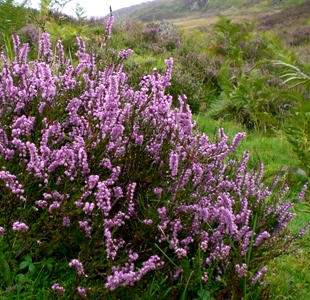Heathlands are in the news!
(Scientifically, that is!) BIO has produced a “wave” of scientific articles about Heathlands recently.

Hovedinnhold
In 2013 alone, 7 articles have been published, one is in press and 3 more are submitted. The papers report on the work of 5 BIO PhD and 3 MSc students.
Why are heathlands important?
The recent scientific focus on heathlands is the result of many factors, explains Professor Vigdis Vandvik, who is involved in most of the work.
The Heathlands represent an ancient cultural landscape, which appeared along the west coast of Europe more than 6000 years ago, as people started using fire to manipulate the coastal landscape to promote year-round grazing. The heathlands support unique biodiversity and provide important ecosystem services, but are now critically threatened due to changes in land use in combination with other global change drivers.
Research is needed to understand the dynamics, biodiversity and ecological value of heathlands, and to efficiently protect and manage the remaining heathland areas, Vandvik says. But for scientists, the greatest value of these areas may be as a model system for studying general ecological phenomena such as species interactions, disturbance, and successional dynamics. Read more on the Ecological & Environmental Change Research Group web pages: Coastal heathlands
The heathlands as a model system
Because of the strong human land-use impacts, the heathlands are, in many ways, ecologically “simpler” than many “natural” systems, and because of the relatively long time periods involved, organisms living in heathlands may have evolved to live in the heathland environment. Vandvik explains that the relatively low plant diversity of heathlands make them suitable for studying, for example, ecological impacts of introduced species.
Vandvik cautions against what she calls nature romanticsism. In many systems and areas, it may be impossible to return to a 'natural' state, or even to define baselines for conservation as the environment of a few hundred or few thousands of years ago, she says. Too many conditions have changed. Realistic questions that we need to address, however, include: where is biodiversity and ecological value found in today's landscapes? what to preserve? how to manage these lanscapes? and identifying threats and priorities.
Need for basic understand of ecosystem dynamics
Change is happening in all landscapes, including the heathlands. What is important to focus on, says Vandvik, is the need to understand the dynamics of our ecosystems. Without knowledge there cannot be effective management. Without effective management, landscapes and biodiversity may be lost before we even know what was at risk.
This year’s high number of heathland publications indicates that BIO researchers are actively contributing to expanding the knowledge base about this interesting and valuable landscape.
There is much to read more about heathland research on the Ecological & Environmental Change Research Group web pages. In particular:
BIO and EECRG are strongly involved with the Heathland Centre
